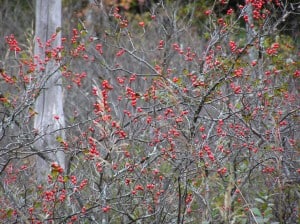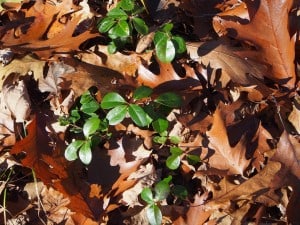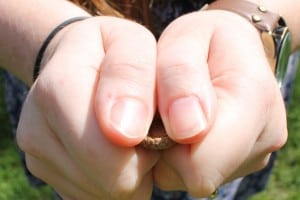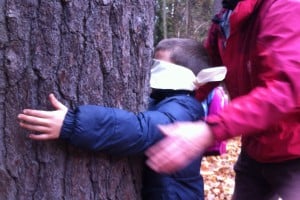“November comes
And November goes,
With the last red berries
And the first white snows.
With night coming early,
And dawn coming late,
And ice in the bucket
And frost by the gate.
The fires burn
And the kettles sing,
And earth sinks to rest
Until next spring.”
– Elizabeth Coatsworth
This week, I would like to propose some things to do to more fully enjoy the often-maligned month of November. A number of these suggestions are part of “The Big Book of Nature Activities: A Year-Round Guide to Outdoor Learning” that I am writing with Jacob Rodenburg, Executive Director of Camp Kawartha. The book should be available in late spring, 2016
A Nature Table
When you are out for a walk this month, collect some items for a home or classroom nature table. These could include a milkweed pod; different fruits and seeds such as acorns, bittersweet and winterberry holly; any remaining colourful leaves, which can be pressed, dried and placed between sheets of plastic wrap; the seed heads of different grasses, sedges and rushes; a bracket fungus from a tree or stump; tree bark covered with lichen; the ball-like gall found on goldenrod stems; abandoned bird nests; and the cones of different species of conifers.
Sketching and photography
If you enjoy sketching or doing photography, November offers all kinds of interesting subjects. Among these are fruit- and seed-clad vines like wild grape, Virgin’s bower, wild cucumber, American bittersweet and Virginia creeper; close-ups of different fungi, lichens, mosses and club-mosses; fallen leaves on the ground or floating in water; the interesting shapes of leafless trees and branches; a tree canopy as seen when lying on your back; and the ice forming around the edge of a pond.
A nature walk
We all enjoy going for a walk with our children or grandchildren, but often wonder what we can do along the way to make the walk more fun. Here’s a few suggestions.
● Stop every once in a while and do a micro-hike using a hand lens or magnifying glass. Some interesting subjects include a rotting tree trunk or areas where there are different kinds of moss. Closely investigate everything from leaf veins, seeds and the underside of mushrooms to lichens, bark, feathers and invertebrates under logs.
● Have everyone lay down on their backs in the leaves of the forest floor – they smell great! -and look up at the leafless canopy and clouds as they pass over. Can you find arrangements of branches that match the lines on the palm of your hand?
● Play Basement Windows. Gently roll over a log, or a rock and peer underneath. Can you find a salamander, a centipede, a pill bug, or maybe an earthworm?
● Stop to feel and smell a leaf, bud or even a piece of mushroom. Rub it gently between your fingers. How does it smell? Share with others. Wintergreen smells wonderful all year-round. You can also stop at different kinds of conifer trees and snip off some foliage. Using a small twig, gather some resin from a pine and maybe a balsam fir, too. Place each item in a separate small plastic bag. Crushing the foliage with the sides of the bag, which will keep the oils off your fingers. Tell the children the name of each species as you pass around the bags and smell what’s inside. Have everyone describe the odour as best they can. Perhaps write the name of the tree on a piece of paper and place it in the bag. Practice smelling for a few minutes, while looking at the name. Then, working in pairs, try to identify each odour, maybe while wearing a blindfold. Who has the most accurate nose?
● Play Exploration Dice. Get two wooden blocks or cubes of any kind. On one cube, place a direction on each face – N, S, E, W, NW, SE. On the other place 6 numbers 4, 8, 12, 16, 20, 24. Roll the dice and walk in the direction and the number of paces indicated (e.g., NW for 12 paces) Then yell “hunker down.” Ask kids to find something interesting close to where they crouched. The dice will bounce you around the landscape to places you might never have explored. There is always something interesting to discover.
● Do a barefoot walk. If the weather is mild, take off your shoes and socks. Put on a blindfold and have another person guide you as you walk across a lawn with patches of sun and shade or across a forest carpeted with leaves or areas of moss – anywhere that is safe and free of sharp objects. Did the ground temperature change? What textures did you feel? Change roles.
● Find an oak tree with acorns lying on the ground. Take the off the cap and place your thumbs over the hollow (on the underside) in a V shape. Blow across your knuckles and over the hollow. You should hear a sharp, whistling sound. If you don’t, try repositioning your thumbs. Watch out for incoming dogs!
● Make a forest tea. As you walk, harvest a handful of white cedar foliage (scale-like and flattened) and white pine needles (long, soft needles in bunches of 5). When you get home – or stopping along the way to make a fire – toss the greenery in boiling water and let it steep for 10 minutes. The resulting tea will be bitter but refreshing, and your tongue will dance with a pungent but evocative taste of the forest.
● A rainbow hike. This activity will help you to see and appreciate the multitude of colours in the forest, even in late fall. You will need paint chip samples (e.g., yellows, reds, oranges, greens, browns, rusts, etc.) or small pieces of paper of different colours from magazine adds. Provide each member of the group with an assortment of different colours. As you are walking, try to find a leaf or other natural item that matches each chip.
● Meet a tree. In this game, children work in pairs. One child is blindfolded and led through a forested area by the other to a given tree, perhaps 10 meters (30 feet) away. The blindfolded player explores the tree with their arms and hands and tries to get an idea of the diameter, the texture of the bark, whether any branches, lichens, holes or large roots are present, etc. The child is then guided back to the starting point, taking a circuitous route. The blindfold is then removed and the child has to find his or her tree. Switch roles.
● Give each child an index card with an X in the center. Tell them the card is a map and the X is where they’ll be sitting. Each time they hear a sound, they should mark its location (direction and distance) and represent it with a simple symbol (e.g., a few parallel lines for wind, a musical note for bird song, a number after the note for each different bird). Show them how to cup their hands in front of and behind their ears to hear sounds from all directions (see focused hearing page X). Make sure that each child finds a listening place well-separated from other children. Listen for 5-10 minutes, depending on the variety of sounds and the age of participants. Encourage kids to share their maps with a partner, identifying natural and human-related sounds. Bring the group together and discuss the following: How many different sounds were heard? Which sounds did you particularly like? What sounds were new to you? Who/what may have made them? Which were natural and which were caused by humans? Do some of these sounds have a purpose? If so, what might they be?



